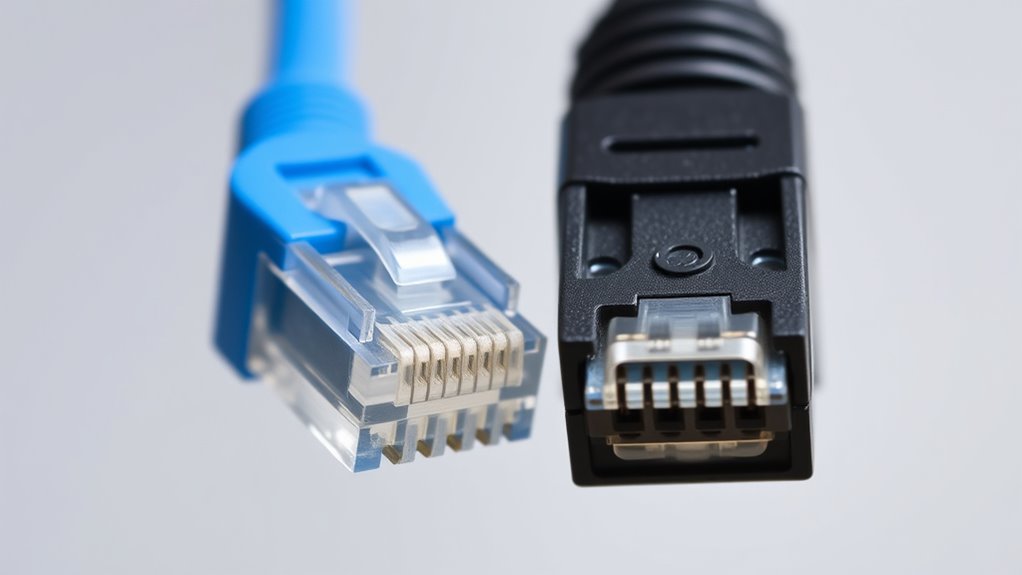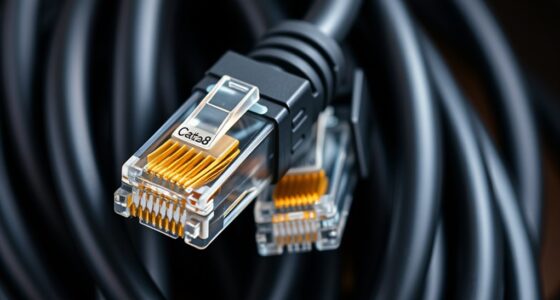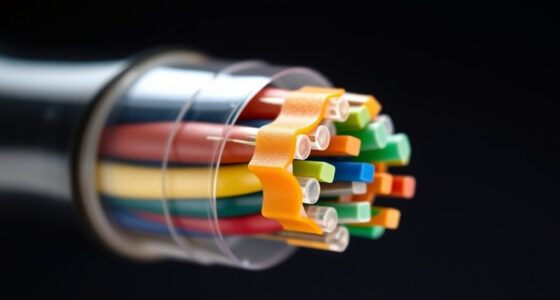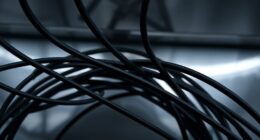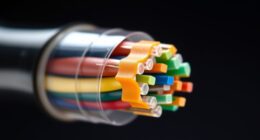You should upgrade from Cat6 to Cat6a if your network needs higher speeds, longer cable runs, or better interference resistance for future growth. Cat6a offers up to 10 Gbps at 100 meters, making it ideal for demanding applications and expanding organizations. Its improved shielding and durability mean your infrastructure stays reliable longer. To make the best choice, consider your current and future needs—more insights ahead will help you decide when it’s time to switch.
Key Takeaways
- Upgrade to Cat6a when high-speed, long-distance, or interference-prone environments demand 10 Gbps over 100 meters.
- Consider switching to Cat6a if current Cat6 cables cannot support future bandwidth needs or organizational growth.
- Use Cat6a in settings with high electromagnetic interference or outdoor applications for better durability and performance.
- Upgrade when existing cables reach their distance or speed limitations, hindering network efficiency.
- Investing in Cat6a ensures future-proofing for emerging technologies like Wi-Fi 6, 5G, and increased data transfer demands.
Differences in Performance and Speed

While both Cat6 and Cat6a cables are designed for high-speed data transmission, they differ markedly in performance and speed. Cat6 supports speeds up to 1 Gbps at 100 meters, while Cat6a doubles that capacity, reaching 10 Gbps at the same distance. This difference makes Cat6a better suited for demanding applications like data centers or future-proofing your network. Enhanced network security measures are also an important consideration when upgrading your cabling infrastructure. Additionally, the cable shielding in Cat6a reduces interference, which can be critical in high-density environments. Fiber optic connections surpass both copper cables in speed and distance, but they require different infrastructure. Wireless connectivity, on the other hand, offers flexibility but can struggle with stability and speed compared to wired options. If you need consistent high-performance, upgrading to Cat6a makes sense. However, for convenience and mobility, wireless may be preferable, even if it sacrifices some speed and reliability.
Bandwidth Capabilities and Future-Proofing

When evaluating cable options for your network, bandwidth capacity plays a crucial role in guaranteeing future growth and performance. Cat6 offers up to 10 Gbps at 55 meters, which may suffice for current needs, but Cat6a doubles that capacity to 10 Gbps at 100 meters. As technology advances, wireless alternatives like Wi-Fi 6 and 5G can supplement wired connections, but they won’t replace the reliability and speed of high-quality cables. Fiber optic options provide even greater future-proofing, supporting hundreds of Gbps for long distances. Upgrading to Cat6a now ensures your network can handle increasing data demands and new applications, reducing the need for frequent rewiring. Choosing the right cabling aligns your setup with future technologies, safeguarding your investment and maintaining peak performance. Additionally, considering the diverse designs and materials of modern cables can further optimize your network setup for durability and efficiency. Incorporating cables with enhanced shielding can reduce electromagnetic interference and improve signal integrity over longer distances. Understanding network infrastructure standards can also help you select cables that meet industry requirements for performance and safety.
Cost Considerations and Budget Planning

When planning your network upgrade, you need to take into account installation expenses and ongoing costs. While Cat6a cables may cost more upfront, they often save you money over time through better performance and future-proofing. Budgeting wisely now can ensure you make a long-term investment that meets both your current needs and future growth. Additionally, considering the efficiency of data transmission can help optimize your network’s performance and reliability over the years. Implementing higher-grade cables like Cat6a can also support higher bandwidth and accommodate increased data demands as your network expands. Incorporating mindfulness techniques during planning can help you make clearer decisions and reduce stress related to budgeting and upgrades. Keeping in mind the importance of cost management in payment processing systems can also contribute to maintaining a balanced budget for your network infrastructure.
Installation Expenses and Costs
Installing Cat6 and Cat6a cables involves different costs that can substantially impact your budget. The installation expenses for each type vary due to factors like cable length, connectors, and labor. Cat6a cables are thicker and require more effort to install, which can increase upgrade costs. You might need additional tools or specialized technicians, adding to your overall expenses. Additionally, the cost of materials for Cat6a is typically higher due to its enhanced specifications. Consider these points: – Longer cable runs may raise installation expenses due to increased material and labor. – Upgrading to Cat6a might require additional conduit or protective pathways. – The higher cost of connectors for Cat6a can impact your budget. Also, understanding the installation process can help in better planning and avoiding unexpected expenses, especially since cable performance can influence the overall project costs and future-proofing needs. Incorporating quality assurance practices during installation can help ensure that the cabling meets industry standards and reduces the risk of costly rework.
Long-term Investment Benefits
While initial installation costs for Cat6 and Cat6a cables vary, considering their long-term benefits can substantially influence your budget planning. Cat6a offers higher bandwidth and better future-proofing, reducing the need for frequent upgrades. This makes it a more cost-effective choice over time, especially as fiber optic technology becomes more accessible and affordable, providing even faster, more reliable connections. Additionally, wireless alternatives are increasingly capable, often meeting your current needs without additional cabling. Investing in Cat6a now can save you money by supporting higher data rates and longer cable runs, minimizing future expenses. Furthermore, understanding network scalability can foster a positive atmosphere during planning and installation phases. Upgrading to higher quality cables like Cat6a can also help optimize electricity consumption by reducing network congestion and improving energy efficiency. Recognizing the importance of technology advancements can guide you in making informed decisions that align with future innovations. By weighing these benefits, you ensure your network remains scalable and competitive, making a strategic long-term investment rather than just a short-term fix.
Budgeting for Network Upgrades
Effective budget planning for network upgrades requires a clear understanding of both initial costs and ongoing expenses. When considering options like fiber optic cables or upgrading to Cat6a, weigh the upfront investment against long-term savings. Fiber optic offers higher speeds but can be more expensive initially, while wireless alternatives may reduce cabling costs and installation time. To stay within budget, consider these factors:
- Cost differences between fiber optic, Cat6, and Cat6a cabling
- Long-term maintenance and upgrade costs
- Compatibility with existing infrastructure and future scalability
- Security vulnerabilities associated with certain technologies can impact overall costs and planning. Being aware of technological advancements can help you make informed decisions that keep your network secure and efficient. Additionally, understanding network performance requirements ensures that the selected cabling meets your current and future needs. Incorporating cost-effective solutions can further optimize your budget without compromising quality.
Balancing these elements helps you choose the most cost-effective solution that meets your needs now and as your network grows. Proper planning guarantees you don’t overspend while future-proofing your network.
Cable Construction and Physical Differences

You’ll notice that Cat6 and Cat6a cables differ in their shielding options, which can affect interference resistance. The quality of the conductor material also varies, impacting signal integrity and durability. Additionally, the outer jacket’s material and thickness play a role in how well each cable withstands physical wear and environmental factors.
Cable Shielding Types
Cable shielding types considerably impact the construction and physical differences between Cat6 and Cat6a cables. Shielding protects against electromagnetic interference, which can affect signal quality. The main shielding types include unshielded twisted pair (UTP), shielded twisted pair (STP), and foil or braided shields. These variations influence cable durability, making some options more resistant to environmental factors. Shielded cables tend to be thicker and less flexible but offer better protection overall. When choosing between Cat6 and Cat6a, consider the shielding type for your environment and performance needs. Proper shielding enhances cable durability, especially in noisy or industrial settings. Innovative materials used in modern cables can further improve performance and longevity in demanding environments.
Conductor Material Quality
The quality of conductor material substantially influences the performance and durability of Cat6 and Cat6a cables. High conductor purity ensures minimal signal loss and interference, giving you clearer data transmission. Pure copper conductors, for example, provide better conductivity and are less prone to corrosion over time, extending the material’s longevity. In contrast, cables with lower-quality or alloy conductors may degrade faster, leading to reduced performance and increased maintenance. When selecting a cable, prioritize those with high-purity copper conductors to ensure your network remains reliable for years. The physical construction of the conductor, including its purity and thickness, directly impacts the cable’s overall lifespan and ability to handle high-speed data, making conductor material quality a key factor in your upgrade decision.
Outer Jacket Durability
Since durability is essential for long-lasting network performance, understanding the differences in outer jacket construction is crucial. The outer jacket protects the internal components and influences the cable’s environmental resistance. Cat6a cables typically feature a thicker, more robust outer jacket, offering better resilience against physical damage. This enhanced construction makes them suitable for demanding environments. In contrast, Cat6 cables often have a thinner outer jacket, which may be less resistant to wear and tear. When choosing between these cables, consider the environment where they’ll be installed.
- Thicker jackets improve environmental resistance
- Material quality impacts overall resilience
- Rugged jackets withstand harsh conditions better
Installation Environment and Interference Factors

Understanding your installation environment is essential when choosing between Cat6 and Cat6a cables, as various factors can influence their performance. The installation environment, including the proximity to electrical equipment or sources of electromagnetic interference, impacts cable choice. If your setup involves running cables near fluorescent lights, motors, or radio transmitters, interference factors may cause signal degradation. Cat6a offers better shielding and higher resistance to interference, making it suitable for more challenging environments. Conversely, if your installation is in a clean, interference-free area, Cat6 might suffice. Also, consider the cable’s physical surroundings—conduits, walls, or outdoor conditions—since these can affect cable performance and longevity. Matching your environment with the right cable ensures reliable speed, reliability, and future-proofing.
Compatibility With Network Equipment

Choosing between Cat6 and Cat6a cables depends heavily on your network equipment’s compatibility. Not all devices support the higher standards of Cat6a, so it’s vital to verify device compatibility before upgrading. Your network hardware must meet connector standards that align with the cable type to guarantee proper performance.
- Confirm your network switch and router support the bandwidth and connector standards of the cable.
- Check if your existing patch panels and keystone jacks are compatible with Cat6 or Cat6a connectors.
- Ensure that your network interface cards (NICs) on computers or servers can handle the cable’s specifications.
Matching your equipment’s capabilities with the cable type prevents connection issues and maximizes performance.
Distance Limitations and Signal Integrity

When it comes to maintaining signal quality over distances, the cable type you select makes a significant difference. Cat6 cables handle up to 55 meters before signal degradation impacts performance, while Cat6a extends this to 100 meters, ensuring better interference mitigation. Longer runs increase the risk of signal degradation and crosstalk, which can slow speeds and reduce reliability. Choosing the right cable depends on your distance needs and environment. Here’s a quick comparison:
| Aspect | Cat6 | Cat6a | Impact |
|---|---|---|---|
| Distance Limit | Up to 55 meters | Up to 100 meters | Longer distances, less degradation |
| Signal Degradation | Moderate | Low | Maintains signal quality |
| Interference Mitigation | Less effective | More effective | Better for noisy environments |
| Data Transmission Speed | Up to 1 Gbps | Up to 10 Gbps | Higher speeds over longer runs |
Use Cases and Application Scenarios

Are you wondering which cable type best suits your specific networking needs? Both Cat6 and Cat6a serve different use cases and application scenarios. For testing scenarios requiring high bandwidth and minimal interference, Cat6a is ideal due to its enhanced shielding and performance. It’s also better suited for environments with environmental considerations like industrial settings or outdoor installations, where durability and signal integrity matter.
Consider these scenarios:
- Data centers needing high-speed, reliable connections over longer distances
- Office networks with high data traffic and future-proofing in mind
- Outdoor or harsh environments requiring robust cabling that withstands environmental conditions
Choosing the right cable depends on your specific needs, testing requirements, and environmental factors. This helps ensure top-notch performance and longevity for your network infrastructure.
When to Plan for an Upgrade in Your Network

Monitoring your network’s performance and capacity is essential because technology evolves rapidly, and your current setup may soon become outdated. If you notice increasing data transfer issues, slower speeds, or frequent downtime, it’s time to contemplate upgrading your network cabling and physical infrastructure. As your organization grows or demands change, older cables like Cat6 might no longer support higher bandwidth needs or future-proofing. Upgrading can improve speed, reliability, and support for new devices. Planning for an upgrade isn’t just about current issues; it’s about anticipating future requirements. Regular assessments of your network’s performance help you identify when your existing cabling no longer meets your needs, ensuring your physical infrastructure remains efficient and scalable.
Frequently Asked Questions
How Does Cable Flexibility Differ Between Cat6 and Cat6a?
You’ll notice that Cat6 cables are more flexible than Cat6a, making them easier to install around tight corners and obstacles. During flexibility testing, Cat6 typically exhibits a smaller cable bend radius, which means it can bend more easily without damage. This increased flexibility allows for smoother installations in confined spaces, whereas Cat6a’s thicker conductors and shielding tend to reduce its bend radius, making it somewhat stiffer and less adaptable to tight bends.
Are There Any Environmental Certifications for These Cables?
Yes, both Cat6 and Cat6a cables can have environmental certifications like RoHS and LEED, which guarantee they meet standards for reducing environmental impact. When choosing cables, consider options that support cable recycling programs, helping minimize waste. These certifications promote environmentally friendly manufacturing processes, and opting for certified cables can contribute positively to your sustainability goals while reducing your overall environmental impact.
Which Cable Type Is More Environmentally Friendly?
Think of choosing the greener cable as picking the least thorny path. Generally, Cat6a is more environmentally friendly because it can be made with biodegradable materials and often aligns better with recycling programs. While both cables have room for improvement, opting for those with eco-certifications or recyclable components helps reduce your environmental footprint. So, go for the cable that’s kinder to the planet—your future self will thank you.
Can Existing Infrastructure Support Cat6a Without Upgrades?
Your existing infrastructure might support Cat6a if it has solid cable durability and was designed for high-performance networks. However, you should check the installation complexity, as Cat6a cables are thicker and less flexible, which could make upgrading more challenging. If your current setup can handle these factors, you may not need to upgrade immediately. But for peak performance, consider whether your infrastructure can accommodate the increased cable size and installation demands.
How Do Cable Sizes Affect Installation in Tight Spaces?
Imagine fitting a thick sweater into a tight pocket—that’s how cable size impacts installation in tight spaces. Larger cables with more insulation and shielding options take up more room, making wiring tricky. When you choose cables, consider their insulation thickness and shielding, as these factors determine flexibility and space needs. Smaller, well-shielded cables can ease installation, especially in cramped areas, saving you time and reducing stress.
Conclusion
So, you’re pondering whether to stick with Cat6 or leap to Cat6a—sounds like a thrilling decision, right? Remember, upgrading might just future-proof your network or turn your office into a tech fortress. Or, hey, maybe you’ll just enjoy the extra cables cluttering your space. Either way, choose wisely, and don’t say we didn’t warn you when your Wi-Fi finally starts running faster than your patience! Happy upgrading—or not, your call.
